The Economics and Statistics Division maintains archives of previous publications for accountability purposes, but makes no updates to keep these documents current with the latest data revisions from Statistics Canada. As a result, information in older documents may not be accurate. Please exercise caution when referring to older documents. For the latest information and historical data, please contact the individual listed to the right.
<--- Return to Archive
For additional information relating to this article, please contact:
March 27, 2023POLICE RESOURCES, 2022 Statistics Canada reports that there were 183.8 police officers per 100,000 residents in Nova Scotia in 2022. This is slightly above the national average (181.3), but below Saskatchewan and Quebec. Prince Edward Island reports the fewest police officers per 100,000 residents (132.4).
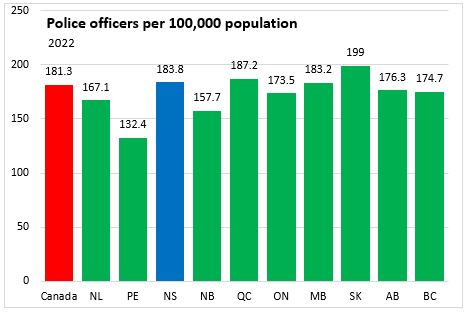
The number of police officers per 100,000 residents has been declining in most years since 2012 (2018 excepted). Nationally, the number of police officers per 100,000 residents has been declining in each year since 2011. Data for 2020 was not collected.
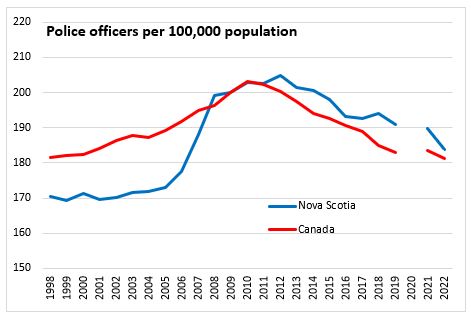
Part of the decline in police officers per 100,000 residents is attributable to changes in the population. From 2012 to 2016 there was a reduction in the number of police officers in Nova Scotia from 1,934 to 1,822. Since 2015, Nova Scotia's population has been rising but the number of police officers has been relatively stable, which results in a declining number of police officers per 100,000 residents.
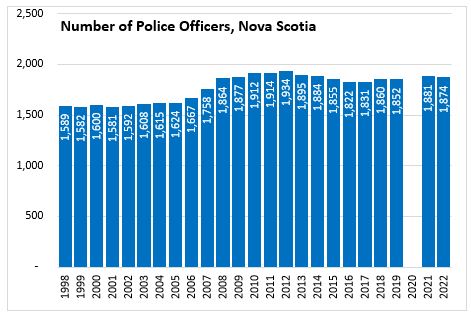
Civilian employees in positions such as clerks, communication, managers, administrative, communications, information technology services, reception and vehicle and facility services were at 665 in Nova Scotia in 2022. Per 100,000 people, civilian and other personnel were 65.2 civilian in Nova Scotia and 84.1 in Canada. The highest rate was in Saskatchewan (97.7) and lowest in Prince Edward Island (55.1).

Civilian and other personnel per 100,000 persons was higher in Nova Scotia during 2006-2017 period before decline in 2018. Canada civilian and other personnel per 100,000 has generally trended up over past 25 years.
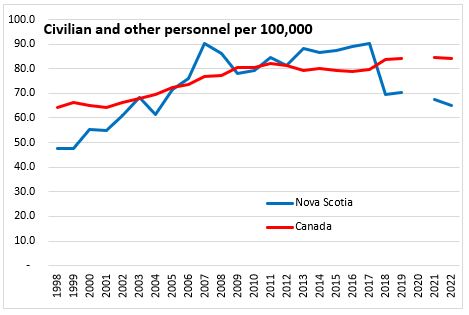
Nova Scotia reported 29.0 Criminal Code incidents per police officer in 2022. This is similar to national average (29.1) and above only Quebec and Ontario. The number of Criminal Code incidents per police officer was higher in all four western provinces.
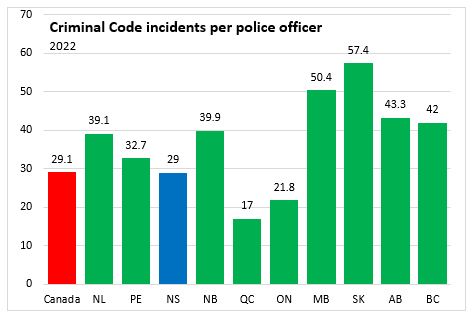
The number of Criminal Code incidence per police officer had been in a long period of decline but has stabilized in recent years in Nova Scotia. Canada's number of Criminal Code incidents per police officer declined in each year from 2004 to 2014 but increased from 2015 to 2019. Canada incidents per police officer was down in 2021 and 2022 compared to 2019.

Nova Scotia's crime severity is also lower than the national average. Crime severity was lower in Ontario, Quebec, and Prince Edward Island. The highest crime severity index was in Saskatchewan and Alberta.
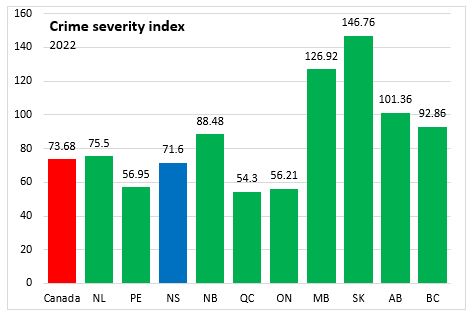
National crime severity started to rise from 2014 to 2019 after a long period of decline, the index was down in 2021 and 2022 compared to 2019. Nova Scotia's crime severity increased from 2016 to 2017 but to smaller extend than nationally. Nova Scotia crime severity index in 2021 and 2022 was higher than 2019.

The portion of police officers who are female is below 25% in all provinces except Quebec. In Nova Scotia, 18.5% of police officers were female in 2022. Nationally, 22.7% of police officers were female.
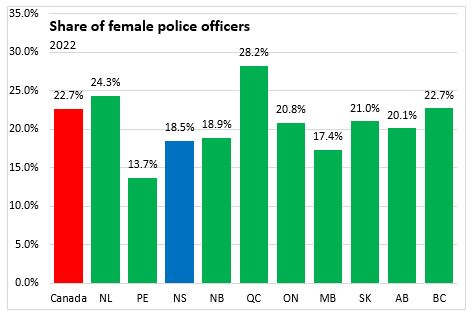
There has been a steady rise in the portion of female police officers in Canada and Nova Scotia. For Nova Scotia, the share of female police officers declined from 19.7% in 2021, all-time high, to 18.5% in 2022.

Source: Statistics Canada. Table 35-10-0076-01 Police personnel and selected crime statistics
Note: The Police Administration Survey was not collected in 2020.
<--- Return to Archive